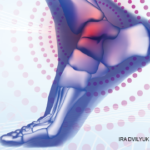Monitoring the fit and use of orthotics can be undertaken during the office visit. If the knee brace is too tight, there can be a concern about compromising circulation or throwing off a blood clot.
It is also possible that a previously well-fitted orthotic may become too loose. For example, the patient who had a high BMI can now get up and walk around more. They are soon 25 pounds lighter and need to have their brace adjusted.
Future Advances
“I think we will see more of the same over the next five years,” says Dr. Nolan. “As the noncustom devices gain greater acceptance, we will be seeing improvements in the materials being used and in manufacturing as well. I don’t see any quantum leaps in the future as much as I see fine tuning what is now available.”
The use of lighter materials will make braces less bulky and easier to hide under clothing. They also breathe better and don’t trap as much heat. There is more diversity in thickness and flexibility.
Dr. Rao thinks that wearable technology will be integrated into orthoses to a greater extent in the near future. Shoes may be able to change the stiffness of the walking surface to help those with foot or knee pain while walking on uneven surfaces. For those with diabetes, their shoes may beep to alert them to critical load or humidity levels.
New cloth is becoming available that can help with comfort issues as well. There are coated products that reduce shear anywhere in the orthotic.
“Off-loading the plantar pressures in the foot is only half of the equation,” says Mr. Janisse. “The other half is avoiding the shear forces that can results in blisters.”
Treatment planning is another area where major advances may be seen during the next five years. Although currently still in the early stages of testing, the use of lasers to make three-dimensional images of the foot or knee may help in further individualizing treatment. The experts also think that the development of treatment algorithms will improve outcomes overall.
For appropriate treatment, those interviewed agreed that it is not important for rheumatologists to be experts in the field.
“I don’t expect the physician to have the knowledge or the background to write a really detailed prescription,” says Mr. Janisse. “If they can tell the diagnosis and what they want the orthotic to achieve, they can leave the rest to me.” the rheumatologist
